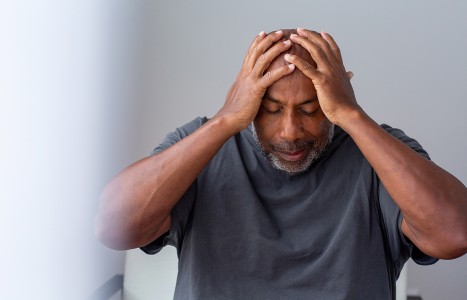Chronic pain afflicts over 20% of the adult population. Sadly, most MDs have essentially no education in treating pain, beyond offering a few toxic medications. Then they tend to steer people with pain away from those health practitioners who are trained. This puts the acupuncture community on the front lines for addressing this epidemic.
An Interview With Zhiyun Bo, Inventor of Abdominal Acupuncture (Fu Zhen)
Q: So, Dr. Bo, what is abdominal acupuncture?
A: Abdominal acupuncture is a new form of acupuncture in Chinese medicine. It involves the application of needles according to the abdominal meridian system (AMS), as introduced by myself. It is therefore known as Bo's Method of Abdominal Acupuncture (BMAA).
Q: How different is it from other forms of acupuncture?
A: It is built upon a combination of existing TCM theories as well as new concepts as devised by me. It is a safer form of acupuncture, due to the superficial penetration of the needles. It is much shallower than conventional techniques and so is less painful, as the de qi is not elicited in the usual way, which patients often find uncomfortable.
Q: Is abdominal acupuncture widely practiced in China?
A: Yes. Such health care establishments as the Zhong Ri Hospital in Beijing, Guang Dong Sheng Hospital, Jiang Su Sheng Hospital, Zhe Jiang Sheng Hospital, and Nanjing Shi Hospital. It is also used outside China, in countries such as Italy and Greece, with excellent results. There have been a number of studies conducted that prove abdominal acupuncture's success, with plans to launch more in the future.
Q: What disorders can it treat?
A: There are many disorders it can treat, particularly in relation to the following: osteo-muscular-articular disorders such as a stiff neck; cervical-dorsum-lumbar spondylopathy; scapulohumeral periarthritis; tendinitis; rheumatoid arthritis; lumbar pain with sciatica; cervical spondylotic syndrome; and arthrosis. It can also treate cerebrovascular disorders, including thrombosis hemiplegia; senile dementia; cerebral arteriosclerosis; angiocardiopathy; hypertension; hysteria; cerebral hemorrhage; and atrophy of the cerebellum. Disturbances of the nervous system such as anxiety, depression, headaches, neuritis and dizziness can also be treated. In addition, it can treat ocular disturbances -- for example, atrophy and retrobulbar neuritis, degeneration of the retina, optic atrophy, cataracts, and glaucoma. Other disorders that can be treated include Parkinson's disease and diabetic neuritis.
Q: When is it contraindicated?
A: Well, of course, you cannot practice abdominal acupuncture on pregnant patients! It is also contraindicated in acute abdominal disorders such as peritonitis and in cases when varicomphalus induces splenomegaly and hepatomegaly. In instances of a malignant celiac tumour, abdominal acupuncture should also not be administered.
Q: When did you discover this new technique?
A: About two decades ago, I came across a resistant case of low back pain with sciatica. Both Western and Chinese medical techniques failed to help the patient. I decided to apply needles at the acupoints qihai (Ren 6) and guanyuan (Ren 4), which are part of the abdominal meridian system and have a connection with the meridian of the lumbar regions. The pain disappeared within five minutes. This was followed with further successes using the same treatment strategy. I then dedicated my time to the further understanding of AMS. Following decades of research into AMS, in 1991, I perfected the AMS theory and established the present protocols for the clinical practice of BMAA.
Q: What are the characteristics and mechanisms of abdominal acupuncture that make is so unique?
A: Acupuncture needles are applied to the AMS, with the acupoint shenque at its center. Varying the degree of penetration depth can dramatically alter the therapeutic outcome. This high level of efficacy is explained in a paper of mine titled "The Importance of the Acupoint Shenque in the Study of the Abdominal Acupuncture."1
In this paper, four main criteria were established:
- The acupoint shenque, at the embryological stage, has formed the cornerstone of all the macroscopic regulations of the body.
- It forms the mother system of all the meridians in the body, known as the shenque system or AMS.
- The shenque system is also responsible for the qi (communication) between the meridians, the auto regulation of blood vessels, and therefore the body's circulation.
- It also acts as the core center of the meridian system.
Q: What is the abdominal meridian system (AMS)?
A: The AMS is a network of meridian acupoints governed by the shenque system. The system regulates the distribution of qi and blood to the whole body. By puncturing specific acupoints on the abdomen, the shenque system can be employed to correct disharmonies and achieve a holistic balance. There are three different levels of puncturing depth, unlike the standard levels of Heaven, Man and Earth used in the Jing Lou system, which are used to treat various disorders. Each level has its own functional mechanism and therapeutic effect.
Q: Can you tell usmore about these three levels?
A: Yes. The three levels can be set out as follows.
The superficial level is located on the congenital AMS, which develops together with the embryo and involves the areas of the head, torso and the upper and lower limbs. The congenital AMS location is represented by the map of a tortoise (figure 1).

Figure 1: The tortoise on the abdomen.2
The intermediate level is located on the standard classical meridian system known as the Jing Luo. This system involves the connection between the superficial level of the congenital AMS and the acquired AMS on the deeper level.
The deep level is located on the acquired AMS, which develops together with the organogenesis and involves all of the visceral organs. The location of the acquired AMS is represented by the ba gua (figure 2). The distinction between the various levels of systems is based on the practical clinical and therapeutic effect. The different eziopatogenesis intervene on different levels of each system. The location of the disease changes according to the course of the pathology, the duration of the pathology, or directly according to the effect of therapy, and therefore changes the functional level of the system.

Figure 2: The ba gua on the abdomen.2
Q: What acupoints do you puncture when using the BMAA system?
A: We use a variety of acupoints located on the abdomen. They include points on the Ren, Stomach and Kidney meridians aswell as new points on the new system, which I discovered during my 20 years of research.
Q: You mentioned before that there have been various studies conducted to prove abdominal acupuncture's effectiveness in clinical practice. Can you give an example?
A: Of course. A study examined the effects of abdominal acupuncture against electro-acupuncture in 98 cases of a prolapsed lumbar intervertebral disc. The number of males was recorded at 57, with 41 females. The age ranged from 20 to 41+. The duration of the disorder ranged from one month to over one year. The number of subjects assigned to the abdominal acupuncture was 50 and 48 in the electro-acupuncture group. The results are shown in the table below.3
| Acupuncture Technique | Abdominal acupuncture | Electro-acupuncture |
| # of Patients | 50 | 48 |
| Completely Effective | 20 (40%) | 14 (29.2%) |
| Significantly Effective | 24 (48%) | 20 (41.7%) |
| Slightly Effective | 6 (12%) | 10 (20.8%) |
| Not Effective | 0 (0%) | 4 (9.3%) |
Q: Have you written any books on abdominal acupuncture?
A: Yes. I have written two comprehensive books on this new technique, as well as books on the shenque theory. At the moment, the abdominal acupuncture books are available in two languages, Chinese and Italian. English and Korean versions are in the pipeline.
References
- Bo Z (1993). The importance of the acupoints shenque in the study of abdominal acupuncture. Journal of Beijing Traditional Chinese Medicine, 4: p.13-14.
- Bo Z (1999). Abdominal Acupuncture, Vol 1. Beijing: Chinese Science Technology Publishing Press.
- Guo F, Ma L, Gong L, Zhang H (2003). 50 cases of prolapsed lumbar intervertebral disc using abdominal acupuncture. Journal of Chinese Acupuncture and Moxibustion, 23, p145.
Acknowledgements
We would like to thank Matthew Bauer, LAc, for his comments and suggestions.



